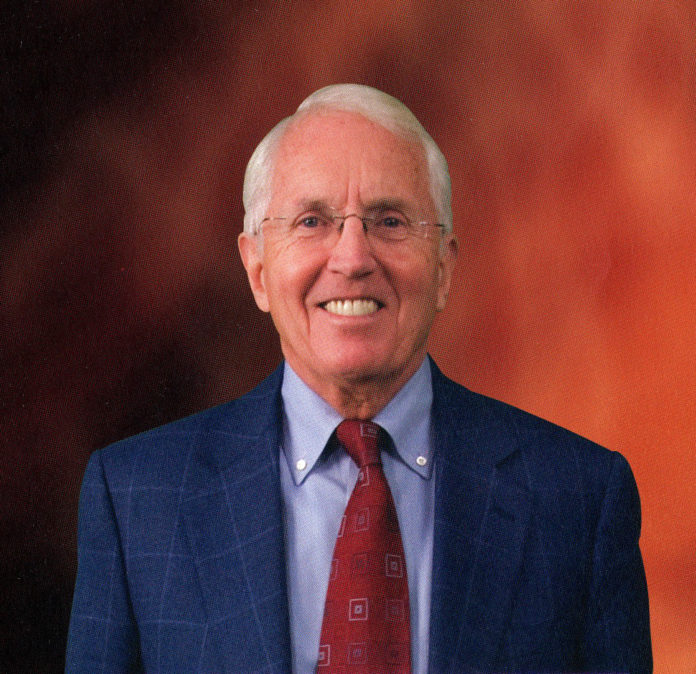
James Prochaska is director of the Cancer Prevention Research Center and professor of clinical and health psychology at the University of Rhode Island. In addition, he is a founder of and consultant to Pro-Change Behavior Systems, an internationally recognized behavior change company in Rhode Island that partners with wellness companies.
The author of more than 400 publications on behavior change for health promotion and disease prevention, Prochaska has served as principal investigator on more than $70 million in research grants on preventing cancer and other chronic diseases. Prochaska, the first psychologist to win a Medal of Honor for Clinical Research from the American Cancer Society, has received many other awards for his work. He talked with Providence Business News about his newest book, “Changing to Thrive,” which he wrote with his wife, Janice Prochaska, Pro-Change’s former chief executive officer and current consultant.
PBN: What are the key take-away messages of “Changing to Thrive”?
PROCHASKA: Five behaviors account for more than 70 percent of chronic diseases, disabilities, lost productivity and premature death. Smoking, alcohol abuse, unhealthy diets, inadequate exercise and unhealthy stress management are the habits that are the biggest threats to health, happiness and thriving. More than 90 percent of adults in the United States have two or more of these high-risk habits.
Most people want to change these behaviors, but they don’t know how. They don’t know which stage of change they are in for each behavior or how to progress through the stages of change. “Changing to Thrive” guides readers through each stage and teaches synergistic strategies for simultaneously changing multiple behaviors with much less effort. As readers progress through the book, they can generate more and more benefits. Not only can they remove their biggest risks, they can, at the same time, enhance multiple domains of well-being: physical, emotional, social, financial and purposeful well-being. The book peaks with the message that more and more readers who need to can progress from suffering or struggling to thriving.
PBN: How does “Changing to Thrive” differ from other self-help books, and who do you hope will read this book?
PROCHASKA: The book is inclusive and is written for those who are ready to take action, for those who are getting ready and for those who are not ready. A key message is, “Wherever you are at, we can work with that.”
During the time of New Year’s resolutions, our society gives people only two choices: Take action or do nothing. Neither of these are good options. The vast majority of people are not ready, and if they take action, they will be among the huge number of people who relapse in the first 21 days after the new year. Those who do nothing will continue to do damage to their health and well-being. What a way to have started the new year!
Based on some of the reviews and sales to date, some colleges are adopting this book for students across health-related disciplines and some companies are buying it to help their employees develop behavior change as a core competency to enhance their personal well-being and their professional health careers. But, we hope to most reach the multitudes of people who have tried to lose weight too many times in too many ways and are demoralized about their inability to do so or the multitudes who have profound doubts about whether the benefits of changing are worth the costs. Their motto is, “When in doubt, don’t act.” It’s like the wisdom of Wall Street, “When in doubt, don’t invest!” For many of these people, their motto is, “When in doubt, don’t invest in your present or your future.” We help such folks appreciate that changing any of the big five habits represents a bargain basement of behavior change. There is nothing else that readers can invest in that can produce more benefits in their lives.
PBN: What is the six-stage process referenced in the book, and what does that process do for readers?
PROCHASKA: With the help of ordinary people, we discovered that changing a high-risk behavior is a process that unfolds over time and involves progress through the stages of change:
- Pre-contemplation is the stage in which people do not intend to take action in the foreseeable future. Most of these people want to change, but they are not ready because they are demoralized from past failures or are defensive because others pressure them to quit smoking, stop drinking, lose weight or exercise – now!
- Contemplation is the stage where people intend to take action in the next six months. Across 48 risk behaviors, for contemplators, the pros and cons of changing are exactly tied, producing a profound doubt that can cause them to be chronic contemplators, who tell themselves, “Some day they are going to change.”
- Preparation is the stage in which individuals are ready to change now. They typically comprise about 20 percent of the at-risk population, but 80 percent of self-help programs are designed for them.
- Action is the busiest stage, where people have to work the hardest to keep from relapsing. Many believe the myth that they can change deadly habits in 21 days. If they ease up on their efforts too soon, they are soon regressing back to old habits.
- Maintenance is the stage where individuals have stabilized their gains and don’t have to work too hard to keep from relapsing. Their biggest challenges occur at times when they are stressed or distressed and are tempted to go back to smoking, drinking, eating comfort foods or lying on the couch. That’s why we start our book with managing stress and distress effectively to reduce the temptations that can drive people to their unhealthy behaviors before and after they take action.
- Termination is the most controversial stage, where people have zero temptation and full confidence across all types of situations that they will not go back to alcohol, cigarettes, junk food or the couch. For those who have abstained from drinking alcohol for years, we address the question of whether it is best to be in recovery for a lifetime, or to be recovered. We also address the issue of healthy eating; for many people who have lost a great deal of weight, they may have to maintain healthy eating patterns for their lifetime.
PBN: You’ve written extensively about behavior changes. Why is it so hard for people to make beneficial changes and what have you found to be the most challenging changes for people to make?
PROCHASKA: The biggest challenge is for people to change their minds, their mental model that construes change as equaling taking action. The action model excludes most people from participating in self-help, wellness or well-being programs designed for the minority, who are prepared to take action now. Around the new year, there is a new mindset that gives everybody the opportunity to break out of demoralization, defensiveness or doubt to make 2017 a happy and thriving time in their lives.
PBN: Tell us about the relationship between cancer and other chronic diseases and behavioral habits, and why you’ve been motivated to study those interrelated issues?
PROCHASKA: We have discovered how those previously identified five behaviors account for more than 70 percent of cancers and other chronic diseases. These chronic conditions are so costly in terms of suffering or struggling, health care and lost productivity. This is a time when we need more individuals and families who are thriving, more schools and churches that are thriving and more companies and communities that are thriving. Our mission in life has been to enhance the health and well-being of as many people as possible. With our recent scientific and practical breakthroughs, we can help more and more people who are suffering or struggling to be “changing to thrive.”











